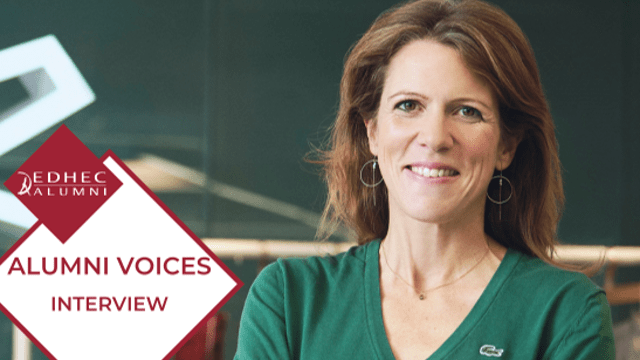Interview with Catherine Spindler (EDHEC Master 1999), Deputy CEO of Lacoste
After some time in cosmetics and e-commerce, in late 2022 Catherine Spindler (EDHEC Master 1999) became Deputy Managing Director of the Lacoste brand. Marking the 90-year anniversary of France’s only sports fashion house, she explained to us that the iconic crocodile brings communities together all around the world and contributes to the emergence of new styles. From tennis to hip-hop and golf to street fashion, follow this guide!
How would you summarise your current position and responsibilities?
Generally speaking, my role covers artistic oversight and the design studio right up to our go-to-market product strategy, as well as product development, merchandising, marketing and communication. So I’m responsible for every market we operate in and all retail traffic, all the way to the end consumer.
Does the target profile of the Lacoste brand change from one period to the next?
We don’t particularly seek to move in that direction. One thing is for sure: we target a very broad audience. Especially since the brand has this extraordinary power to speak to generations, communities and cultures that are as numerous as they are different. The crocodile, seen by most people as a veritable icon, brings them all together. The brand’s 90-year anniversary is a celebration of the communities that have “made” Lacoste. For our campaign, we showcased communities who have truly adopted the brand: Lacosteiros in Brazil, vintage fashion collectors in Japan, tennis fanatics in South Korea – distinct from French Open fans in Paris –, amateur golfers in Miami and young golfers from the Prado in Marseille, to name but a few. We give these communities free rein, as they are the brand’s strength and richness. They inspire us as much as we inspire them.
How is designed tackled with a view to speaking to all of these communities?
By delving back into our heritage. The talented people who have relayed one another in our artistic management teams always draw from our archives and add that extra touch to ensure that we continue to innovate and move the brand forward. Some used them to create a silhouette that in turn inspired other changes in style, always with a blend between sport and fashion. When in 1926 René Lacoste tore off his sleeves to create the polo shirt, it was a very liberating gesture. The clothes that we develop always reflect our unique, French know-how. A V-neck goes perfectly well with tracksuit pants: casual elegance is intrinsic to our brand, a reflection of the period we live in.
What’s the secret to seducing different generations?
Lacoste is an inter-generational brand par excellence. That was the focus of our recent campaign, which included the image of a young man and a slightly less young lady, both wearing pink polo shirts. The campaigns we work on sometimes adopt more of a pop approach, targeting younger audiences, but the brand’s essence remains, that which ensures that everyone can identify with it. Indeed, each year we use a barometer to measure how the brand is evolving by age group. It’s interesting and reassuring to see that we are managing to maintain our historic clientele while at the same time recruiting new generations.
How do you continue to attract the interest of younger generations?
Well first of all it’s thanks to our commercial offer and communication approach of course. But beyond those dimensions, against the backdrop of a fast-moving world, we also consider contemporary expectations when it comes to fashion. And younger people’s expectations are quite different. Ours is a brand with fundamentals that can speak to everyone, including younger generations. We work a lot on product sustainability, for example improving our cotton fibres for better resistance to multiple wash cycles. And for 16 years we have made commitments through our Foundation: we have already offered support to 150,000 young people through development and self-esteem programs via sport, which we fund in the main countries where we have a presence. Sustainability, societal commitments and transmission are topics to which upcoming generations are sensitive, as are we.
Are the brand’s tennis, golf and lifestyle inspirations sufficient for its long-term development?
Authenticity is a very important notion at Lacoste, and the worlds through which we express ourselves reflect those in which we have legitimacy. We still have much to do in tennis and golf, in particular to reassert our contribution to these worlds, which in recent times have seen others get the jump on them, albeit in less obvious ways. At the same time, we have started to develop other offers, such as our training product range. We also take inspiration from sports whose communities have adopted the brand or which, like breakdancing, have acquired Olympic recognition and especially feed into the lifestyle and streetwear dimensions of our brand. Furthermore, we are working to accelerate the development of our footwear, with huge stakes in business and a capacity to recruit new clients, young ones in particular. I would also like to expand our women’s category, which is a huge driver of desirability for a brand like ours. Indeed, our archives reveal that in the past it was a highly feminine brand, with silhouettes that very much resonate with the contemporary world.
How has sport influenced the brand’s values?
The values of sport are central to our company values and managerial culture: teamwork, elegance (style, but also behaviour as in fair play), tenacity and audacity. Sport instils a great amount of humility and teaches us to push back our limits. Lacoste is enjoying a positive trajectory of success, but we nonetheless remain extremely humble and cautious, mindful that the coin could flip. At the same time, we continue to set ourselves ambitious objectives so we can keep showcasing the colours of this French heritage brand, which now enjoys world renown. That, too, is a kind of duty on our part in respect of the brand.
Nowadays e-commerce has become an essential component of any fashion company’s strategy. What is the next stage that will really make a difference?
Digital technology has given us both a retail channel and a tool to bring consumers new experiences. The basic, albeit important, challenge for most textile brands is cross-channel retailing. As I see it, digital technology is more about creating bridges with the physical world. In the near future, there will be highly interesting areas in terms of creation using artificial intelligence. But I still believe strongly in the “physical” realm, because it holds the key to surprising and capturing new clients. Fashion brands shouldn’t lose sight of the fact that physical aspects will play a structural role in those formats that are subject to huge changes going forward. Community experiences can be an important part of the customer experience via feelings of exclusivity. Some of our customers who came to us through the communication platform Discord were invited to the French Open, and they regularly visit our flagship store on the Champs-Elysées for exclusive events. They are stakeholders in our product creation and give us feedback. More than ever, we need to find ways to engage them, and these differ considerably depending on the nature of each client.
Do you engage with people in all four corners of the globe in the same way?
No, because cultures are different. In Japan, vintage and collector’s items are much more powerful keys to entering the market than elsewhere. And so our approach is adapted to the reality of each market. In our campaign, we chose eight communities, but we could have used many more. These communities have become brand ambassadors in their home countries with quite an incredible impact. It’s also interesting to see how, for example, golf is becoming a cultural and fashion phenomenon in the United States and South Korea.

Comments0
Please log in to see or add a comment
Suggested Articles




